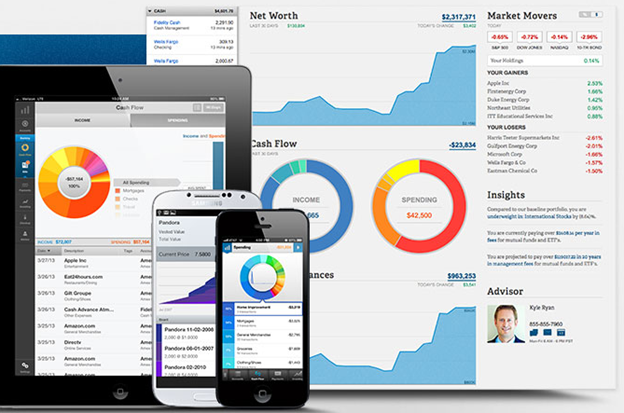Personal Capital – Financial Advisor Review
As a connoisseur of finance and all things money, I have a natural curiosity to investigate new money hacks. Personal Capital investment management caught my eye and is worth a hard look.
“The investment industry is filled with salespeople pushing product. Our mission is to offer truly personal and objective wealth management for the internet age.” Bill Harris, Personal Capital, founder and CEO.
For beginning wealth builders with basic money management needs, Mint.com is fine. Personally, I’ve used Quicken on my desktop computer for several decades, before most of the online tools were even available. Not one to stay mired in the past, I’m impressed by Personal Capital’s offerings. And Bill Harris, the founder of Personal Capital is a former CEO of Intuit, Quicken’s parent, understands the online money management arena. In fact, Harris is also a former CEO of Paypal.
If you’re looking for a comprehensive portfolio management tool, with an option to receive personal guidance from an investment advisor, Personal Capital may be for you. Personal Capital offers one of the most comprehensive financial management services online.
Check out this Personal Capital Review for a peak into a combined technology influenced and human touch money management program.
Personal Capital Overview Snippets
In prepping this review, I was impressed with the breadth of their service.
After inputting and linking all your financial accounts you receive a free digital snapshot of your finances.
Notice how the graphs of your net worth and cash flow give you a clear picture of what you own, what you owe, and your current cash flow situation.
The program offers the backbone of portfolio management; an asset allocation based upon your risk tolerance and time horizon.
But the part that I liked the best from this screen were the “Insights”.
The insights section stated that this investor is underweight in international stocks and is paying over $3,400 in fees per year.
The ability to drill down into one’s portfolio is a skill that a computer is better optimized to handle than an individual. And fees and asset allocation are components of portfolio management that, when managed well, can lead to greater wealth in retirement.
What Does Personal Capital Offer You?
If you have a few thousand dollars in investments or several million, you may benefit from Personal Capital investment management.
“Personal Capital offers an integrated investment platform with multiple options and levels of involvement, from free analysis software to financial advisor services (for those with over $100,000 in investable assets). It provides account linking so you can monitor your finances all in one place, alongside several free tools and an integrated dashboard from which users can:
- Monitor asset allocation.
- Identify potential portfolio risks.
- Calculate their mutual fund fees over time.
- Understand how 401k fees may impact their retirement goals.
- Personal Capital also brags award-winning mobile apps, including a newly released iPad app, allowing users to easily manage their money from anywhere.” According to a NerdWallet.com review.
Taste of Personal Capital Components
1. Personal Fund– This is your individualized financial road map. After a quick chat with a financial advisor (free) and inputting some financial account data (see the screen below), you receive a personal money strategy which will guide you to reach your financial goals.
2. Universal Checkbook. This online app makes it easy to transfer funds between accounts. It’s a nice feature to have, especially if you’ve got several investment and bank accounts.
3. Tax Optimization. It’s not what you make, its what you keep. The frequently overlooked decisions of in which account to place your assets and when to sell can save thousands of dollars over your lifetime. Optimizing asset placement will ultimately net you more money.
4. Personal Financial Advice. If you have more than $100,000 to invest, Personal Capital sets you up with a registered investment advisor. If you employ the financial services of the advisor you pay a small annual fee (a percent of your annual portfolio worth). This type of money management in the financial services arena is quite common. The financial advisor is held to a “fiduciary standard” and is required by law to act with your needs as the only factor for consideration. (This is unlike a stock broker who is paid by commission.)
5. Up front fee disclosure. It’s quite difficult for the average Jane or Joe to know exactly how much they are paying in fund fees, commissions, expenses etc. This program aggregates all of your fees in one place. Would you pay for a plane ticket without knowing the cost? Yet most of us have no idea the total amount of our portfolio management expenses.
6. Free or pay advisor a percent of assets under management. If you are a do-it-yourselfer, you can use all of the portfolio management tools for free. If you’d like advisor informed portfolio management, you can assign $100,000 or more of your account to be managed by Personal Capital; with your consultation and input.
7. Security. Personal Capital employs the highest level security available to protect your sensitive financial data.
What’s the Drawback?
You have to input all of your accounts. Of course this step is true with any financial management system. Nevertheless, I don’t care for the time and effort required to input and sync all of my financial accounts. If you only have a few accounts, this probably won’t be much of a problem for you.
This is best used as an investment and money management tool. Thus, if you don’t have much in the way of investments yet, you’re better off waiting until you have a bit more wealth saved up. In this case, Mint.com is probably a better choice for you.
I suggest giving Personal Capital investment management a test drive to see how it works. It’s free, so the only real downside is the time it takes to input your financial account data. And, as you can see from the top image, the initial account set up is fast and easy.
Write in and let me know what you think. I’d love to hear your comments.
Which online personal finance tools are you currently using?
Related
Quicken vs Personal Capital-Which is Best?
Keep Your Finances Organized in Four Easy Steps
4 Investment Analysts and Managers to Watch
Best Personal Investment Strategy – For Women (and Men)
Disclosure in accordance with FTC rules; If you purchase the advisor service through a link in this article, I may receive an affiliate payment.


